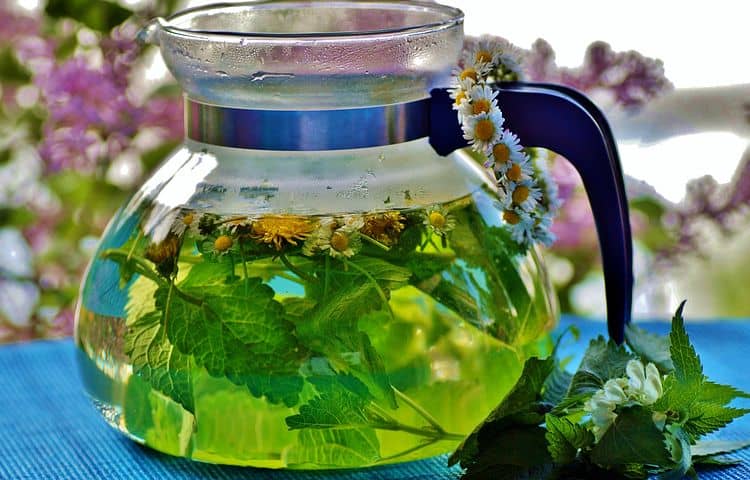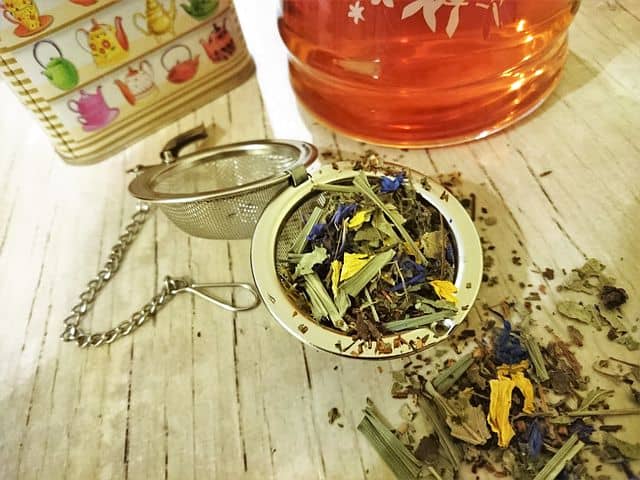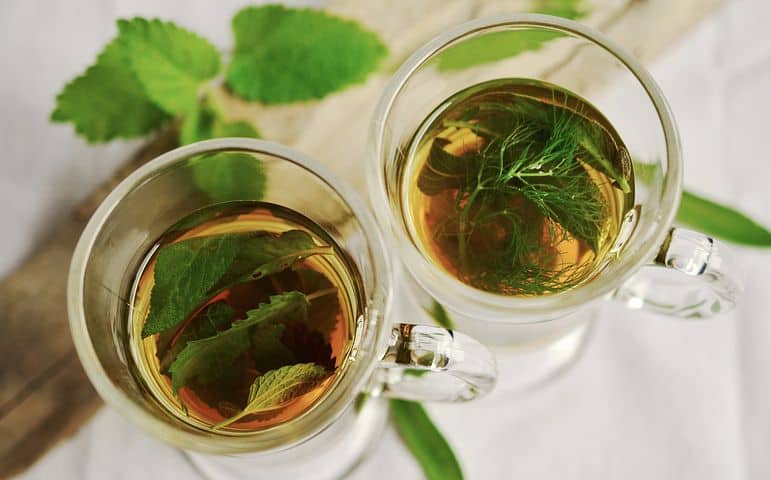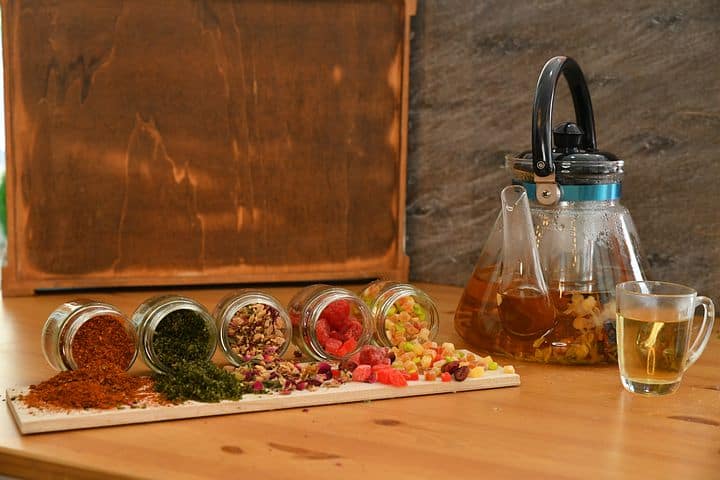I finished reviewing a collection of teas that were herbal. There were various herbs and fruits used such as:
- Rose
- Peach
- Star Anise (a favorite)
- Chamomile
- Apple
- Ginger
The list of beneficial herbal teas can go on and one. Healthy herbs are the ingredients to add to your tea. The healthy herbs even make a great drink on their own. The health benefits of most herbs, fruits, and spices are astounding.
But one thing an herb is not is a tea. What I want to teach you today is about the health benefits of herbs and also why we need to stop calling it a tea.
But, if it’s not a tea, then what is it?

What is an Herbal Tea
“In a lot of ways, we might get more benefit from a good organic tisane than from a vitamin pill,”
Herbalist Marianne Beacon
One of the most frustrating things to an avid tea drinker is an herb referred to as tea. It’s not that herbs are not healthy or good for you. It’s not even that an herb cannot be put into hot water (sometimes cold) and make an amazing drink. It’s the fact that an herb is not a tea.
Tea is a tea because it comes from a singular plant. That plant is the Camellia Sinensis. All tea comes from this plant. If what you are drinking did not come from the Camellia Sinensis plant then it’s not a tea.
So, what do you call our herbal drinks? Does it have a name? Yes, it does. The name of an herbal drink is a tisane. Tisane means herbal tea, a beverage made by infusions of herbs or drink made from other plants. Interestingly enough, this is exactly what a tisane is. However “tea” is looked at as a generic drink for anything we brew in hot water. Today we will talk about the health benefits of herbals.

Health benefits of herbal teas
Herbal teas are made from herbs, fruits, seeds, or roots steeped in hot water. Herbal teas have lower concentrations of antioxidants than green, white, black, and oolong teas. Their chemical compositions vary depending on the plant used. Herbs do not contain caffeine, another plus for the tisane.
Below is a small offering of the varieties of herbs include
- ginger
- Ginkgo Biloba
- ginseng
- hibiscus
- jasmine
- rosehip
- mint
- rooibos (red tea)
- chamomile
- echinacea
There is limited research that has been done on the health benefits of herbal teas. Unsupported claims that herbal tea can help to shed pounds, stave off colds, and bring on restful sleep. Yet, herbs have been used for years if not decades and more to heal all manner of infections and disease. We only need to research and we will see their uses from the past. All herbal teas seem to contain at least one helpful benefit and that is being an antioxidant agent. This article will explore a few more popular herbs and their benefits.
So what about those healthy beneficial herbs? Let’s look at some more popular herbs and their health benefits.
Peppermint – gas, bloating, muscle spasms, stomach aches, support digestive tract health
Ginger – curbs nausea, vomiting, motion sickness, antioxidant, disease-fighting, fights inflammation, helps heal stomach ulcers
Chamomile – Calming effect, coughs, bronchitis also used as a sleep aid, chamomile, can be good for people with irritable bowel syndrome because it is an antispasmodic
Dandelion – I have a whole article on a dandelion that you can read HERE
Rooibos – High amounts of vitamin C from South Africa, high antioxidants, helps bone health, allergies, and kidney stones.
Lemon Balm – Improves concentration, helps skin elasticity, improved markers of lipid and DNA damage, may lower HBP, improves your mood
Alfalfa – Calming, stomach aches, and pains. Alfalfa is also a natural laxative and diuretic and also a good source of vitamin K
Milk thistle – Milk thistle is a protector of the liver. It cleanses the liver and helps to strengthen.
Holy basil or Tulsi tea – Has been used by Ayurvedic practitioners for centuries to help keep the immune system strong after injuries or illnesses thanks to its antibacterial, antifungal, and anti-inflammatory properties.
Rosehips – That bulb under the flowering part. High in Vitamin C, anti-inflammatory, antioxidants to fight the aging skin.
Hibiscus – Antiviral, fights flu symptoms, helps to reduce high blood pressure,
Echinacea – Prevent colds and help heal the ones already have. helps boost the immune system
Passionflower Tea – Improved sleep, reducing anxiety, irritability and agitation Yet, another study found that passionflower helped relieve the mental symptoms of opioid withdrawal, such as anxiety, irritability, and agitation, when taken also to clonidine, the medication usually used for opioid detoxification treatment.
Sage Tea – Brain Health, help cognitive brain health, improve blood lipid levels.
Moringa – A plant that’s native to South Asia, has been known for its medicinal properties and is now quickly becoming a mainstream superfood. With more calcium than milk, as well as iron, vitamin A, and K, moringa tea is a great addition to help keep those bones strong.

How to grow your own healthy beneficial herbals
Growing and a garden and picking out your plants will depend on the zone that you live in. You can find your zone on the internet or my favorite the Farmers Almanac.
The following list is the herbs you can grow in your own backyard. Some you may even find in your own backyard if you know what to look for. You can also choose to grow in containers on your patio. I suggest growing your mint in containers. Mint has the ability to take over an area and control it for years to come. Trust me on that.
- Lemon Balm – Uses the leaves for a calming effect
- Mint – Use the leaves for a calming effect and digestive aid
- Ginger – Use the root of this plant to help your digestion and flu-like symptoms
- Thyme – Use the leaves as an antioxidant
- Chamomile – buds are used to calm the nervous system and reduce stress
- Jasmine – pick the leaves early in the morning to aid with metabolism
- Lavender – Uses the buds for a calming effect
- Sage – Leaves are used to aiding in memory function and blood lipid levels
- Marjoram – Uses the leaves to help ulcers, digestion and improve insulin tolerance
- Cilantro – The leaves contain 5% daily value of vitamin A
- Rosemary – Use those leaves for digestion and increasing circulation
- Fennel – The leaves and seeds are used to enhance muscles and treat kidney stones
- Catnip – Uses the leaves for a calming effect
- Dandelion – The stem and flower assist with an appetite and urine production
- Lemon Grass – The stalk is used as a calming and digestive aid
How To Harvest Herbs
I’ve done a bit of research on this having grown my first herbal garden last year. I had a lot to learn and honestly it was the best experience ever.
Growing my own herbs was a great experience. My garden was not large, in fact it was a raised bed on three levels.
This year I moved the garden closer and increased its size.
You want to harvest your herbs in the early morning hours. This is when they are the freshest and the dew has left the ground. Most herbs are better before they bloom, yet some blooms are used for beverages.
Be tender and loving with your herbs. Try not to twist or tear but cut or pinch with love.
You can dry your herbs in a dehydrator or hang them to dry slowly. I prefer to hang mine using a thread and I hang them in my kitchen. It looks so nice and smells so good.
You use your fresh herbs in your Tea, use about 3 teaspoons full
Dried leaves only need one teaspoon per cup. Of course the longer the brewing the stronger the taste. The average brewing time is 3-5 minutes.
To brew your tea and get the most health benefits out of each herb you will want to use the infusion method. This technique uses water that is under the boiling temperature. The plant leaves, buds and, petals are dipped into the water. Allow them to sit there for a period of time drawing out the essential oils and nutrients.
Have fun and mix up your herbs and see what works best for you. There is no right or wrong when combining healthy herbs into a tea. What tastes best to your palate and what your body needs are your only two concerns.

Summary
Getting my hands into the dirt was therapeutic and calming. I enjoyed planting, caring, and harvesting my little garden. I learned that mint is a crazy takeover vine but grows exceptionally well in a container. I also learned a new hatred for mosquitoes that ate me alive near harvest time. I loved sharing my herbs with my neighbors and wished I had more to share with my friends at work. I also love being able to share the knowledge I have gained with you.
Are you planning on planting a garden? Let me know what you decide to plant and later on let me know how it grows.


2 thoughts on “15 Herbal Teas, Their Benefits And How To Brew Them”
Pingback: When was the last time you made sun tea - My Tea Vault
Pingback: What Does Tea Taste Like? Let's Explore Tea Varieties Taste - My Tea Vault